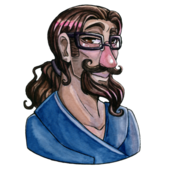I'm making a 2D river, and shifting the texture coordinates of the water based on a low resolution "flow map". Each pixel in the flow map is 24x24 pixels on-screen.
Everything is mostly working fine, but I'm getting a weird distortion where pixels are interpolating between the flow map.
I'm animating the tex coords based on time, and passing in the time via a uniform, from 0.0 to 1.0.
What's weird is that the distortion is non-existent at a time of 0.0, and gets worse and worse until 1.0.
At time = 0.0, no distortions
At time = ~0.5, some distortions
At time = ~1.0, lots of distortion
[YouTube video demonstrating the glitch]
(Notice it snap back around the 5-second mark of the video - that's when uWaterCycle reaches 0.0 again)
I tried to simplify the shader as much as possible to narrow in on what's going on, but something is eluding me.
I understand the texture won't line up perfectly, since the texture only tiles at the seams, but here it'll be sampling arbitrarily. Regardless, I don't understand why the lines are all streaky and seemingly moving sideways?
uniform float uWaterCycle; //Goes from 0.0 to 1.0, based on time.
void main()
{
//=======================================================================================
//...snip irrelevancies...
//=======================================================================================
//The "flow map", where each pixel represents the water flow of a 24x24 pixel area on-screen.
vec4 areaWaterCell = texture2D(Area_WaterCellTexture, fArea_WaterCellCoord);
//Water direction.
vec2 waterDirection = areaWaterCell.rg;
//Convert from (0 - 1), to (-1 to 1)
waterDirection = (((waterDirection) * 2.0) - 1.0);
//Multiply to increase water flow speed.
vec2 waterDirectionX10 = (waterDirection * 10.0);
//Get the primary water texture.
vec4 waterDiffuseFrag = texture2D(Water_DiffuseTexture, fWater_DiffuseCoord + (waterDirectionX10 * -uWaterCycle)) * Water_Coloration;
//=======================================================================================
//...snip irrelevancies...
//Set this color as the output.
ColorBufferOutput = waterDiffuseFrag;
//=======================================================================================
}









